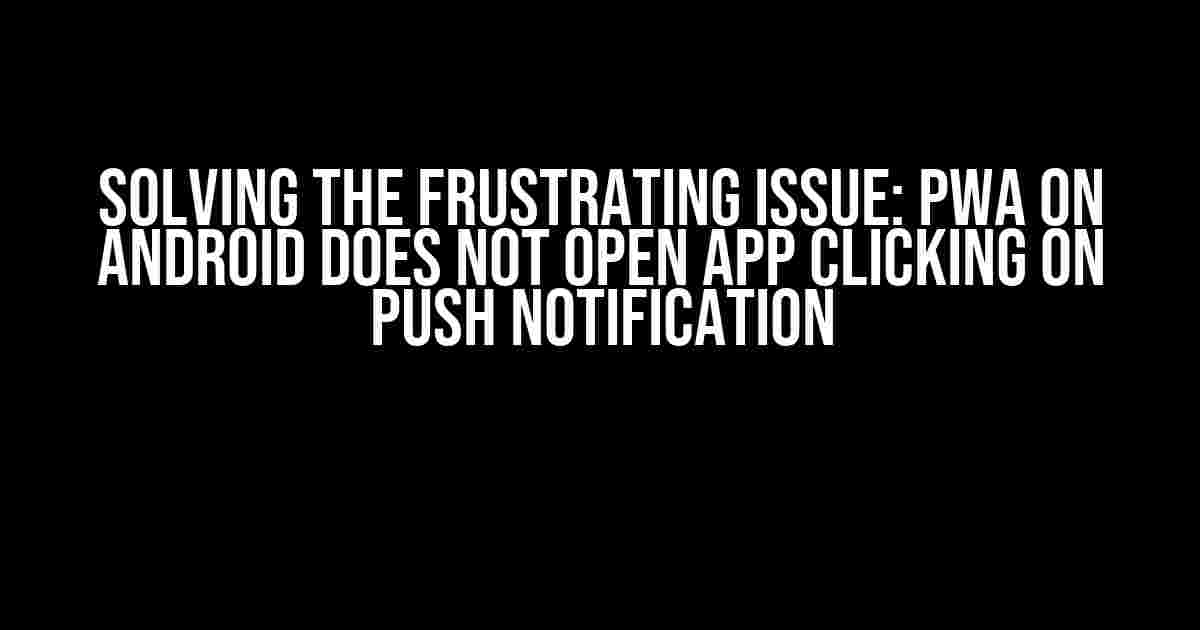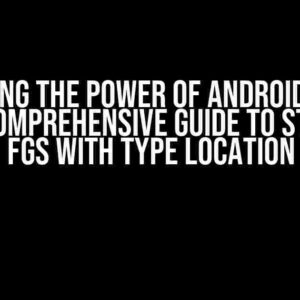Are you tired of scratching your head, wondering why your Progressive Web App (PWA) on Android doesn’t open when you click on a push notification? You’re not alone! This common issue has been driving developers crazy, but fear not, dear reader, for we’re about to dive into the solution.
Understanding the Problem
PWA’s are designed to provide a seamless user experience, but sometimes, the notification-click-to-app flow just doesn’t work as expected. When a user clicks on a push notification, the app should open, but instead, the notification is dismissed, and nothing happens. This can be attributed to various reasons, including:
- Incorrectly configured notification channels
- Missing or malformed intent filters
- Inadequate handling of notification clicks
- Android’s notification system quirks
Step 1: Verify Notification Channel Configuration
To ensure your PWA is correctly configured, let’s start by reviewing your notification channel settings.
// Check your web app's manifest.json file
{
"name": "My PWA",
"short_name": "My PWA",
"theme_color": "#4A4A4A",
"background_color": "#4A4A4A",
"display": "standalone",
"icons": [...],
"notification_channels": {
"my_channel": {
"name": "My Channel",
"description": "My channel description",
"importance": "high"
}
}
}
Make sure you have a valid notification channel configuration in your `manifest.json` file. The `notification_channels` property should contain an object with a unique key (in this case, “my_channel”) and a corresponding configuration object.
Step 2: Check Intent Filters
Intent filters are crucial for Android to recognize and launch your PWA when a notification is clicked.
// In your web app's manifest.json file
{
...
"intent_filters": [
{
"action": "android.intent.action.MAIN",
"category": [
"android.intent.category.LAUNCHER"
]
}
]
}
Verify that your `manifest.json` file includes the necessary intent filter configuration. This tells Android to launch your PWA when a notification is clicked.
Step 3: Handle Notification Clicks Correctly
In your PWA’s JavaScript code, you need to handle notification clicks using the `Notification` API.
// In your JavaScript file
self.addEventListener('notificationclick', event => {
const notification = event.notification;
const primaryKey = notification.data.primaryKey;
// Perform the desired action, such as opening the app
clients.openWindow('/');
event.waitUntil(clients.openWindow('/'));
});
In the code above, we’re listening for the `notificationclick` event and extracting the notification’s primary key. Then, we use the `clients.openWindow()` method to open the app when the notification is clicked.
Step 4: Test and Validate
Now that you’ve configured your notification channel, intent filters, and notification click handling, it’s time to test your PWA.
- Build and deploy your PWA to an Android device.
- Schedule a push notification to be sent to your device.
- Click on the push notification.
- Verify that your PWA opens as expected.
If your PWA still doesn’t open, try troubleshooting with the following tips:
- Check the Android device’s notification settings to ensure notifications are allowed for your PWA.
- Verify that your PWA is installed and configured correctly on the device.
- Test your PWA on different Android devices and versions to rule out device-specific issues.
Bonus: Additional Troubleshooting Tips
If you’re still experiencing issues, consider the following advanced troubleshooting tips:
| Troubleshooting Tip | Description |
|---|---|
| Use the Android Debug Bridge (ADB) | Utilize ADB commands to inspect notification channels and intent filters on your device. |
| Check the AndroidManifest.xml file | Verify that your PWA’s AndroidManifest.xml file contains the necessary intent filters and configurations. |
| Inspect the Notification object | Log the `Notification` object’s properties to ensure it contains the expected data and configuration. |
Conclusion
Solving the issue of your PWA not opening when clicking on a push notification requires a thorough understanding of notification channels, intent filters, and notification click handling. By following the steps outlined in this article, you should be able to resolve this frustrating problem and provide a seamless user experience for your Android users.
Remember to test and validate your PWA regularly to ensure it continues to function as expected. Happy coding!
Frequently Asked Question
Get answers to some of the most frequently asked questions about Progressive Web Apps (PWAs) on Android not opening when clicking on push notifications.
Why doesn’t my PWA open when I click on a push notification on Android?
This issue typically occurs when the PWA is not properly configured or registered on the device. Ensure that your PWA is correctly installed and registered on the user’s device, and that the notification is properly configured to open your PWA.
Do I need to add any specific code to handle push notifications in my PWA?
Yes, you need to add the necessary code to handle push notifications in your PWA. This includes registering a service worker, handling notification events, and opening your PWA when a notification is clicked. You can use libraries like Firebase Cloud Messaging (FCM) or OneSignal to simplify the process.
Are there any specific Android settings that could affect PWA notifications?
Yes, some Android settings can affect PWA notifications. For instance, if the “Do Not Disturb” mode is enabled or the notification shade is disabled, your PWA notifications might not work as expected. Additionally, ensure that your PWA is whitelisted in the Android notification settings.
Can I use a third-party library to handle push notifications in my PWA?
Yes, you can use third-party libraries like Firebase Cloud Messaging (FCM), OneSignal, or Pushpad to handle push notifications in your PWA. These libraries provide easy-to-use APIs and SDKs to simplify the process of implementing push notifications in your PWA.
What are some common mistakes to avoid when implementing push notifications in a PWA?
Common mistakes to avoid include not registering the service worker correctly, not handling notification events properly, and not providing a valid URL to open when the notification is clicked. Additionally, ensure that your PWA is correctly configured and registered on the user’s device.


